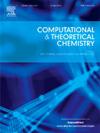High gas-sensing performance of SF6 decomposition gases on PdSe2/MoS2 heterojunction: A DFT study
IF 3
3区 化学
Q3 CHEMISTRY, PHYSICAL
引用次数: 0
Abstract
Partial discharge faults in gas-insulated switchgear seriously affect the operational stability of power systems. In this paper, based on the density functional theory (DFT), the PdSe2/MoS2 heterojunction was theoretically constructed. The adsorption performance and gas sensing characteristics of the PdSe2 monolayer and the heterojunction after adsorbing the decomposition products of sulfur hexafluoride (SF6), namely H2S, SO2, SO2F2, SOF2, and HF, were investigated using the first-principles method. The results show that incorporating MoS2 into the PdSe2/MoS2 heterojunction greatly enhances the gas adsorption capacity of the monolayer, with the adsorption behavior of the SO2 molecule transitioning from physical adsorption to chemical adsorption. Through the calculation of adsorption energy, energy gap, charge transfer, projected density of states, charge density difference, molecular orbitals, work function, and recovery time, it was found that gas molecules adsorb on the surface of PdSe2/MoS2 to form stable structures, and the order of adsorption ability was SO2 > SO2F2 > SOF2 > H2S > HF. Meanwhile, the gas sensing properties of PdSe2/MoS2 heterojunction for gas adsorption are superior to those of intrinsic PdSe2. Therefore, PdSe2/MoS2 has potential application prospects in gas sensors for detecting SF6 decomposition gas.

SF6分解气体在PdSe2/MoS2异质结上的高气敏性能:DFT研究
气体绝缘开关柜局部放电故障严重影响电力系统的运行稳定性。本文基于密度泛函理论(DFT)从理论上构建了PdSe2/MoS2异质结。采用第一性原理法研究了PdSe2单层膜及其异质结吸附六氟化硫(SF6)分解产物H2S、SO2、SO2F2、SOF2和HF后的吸附性能和气感特性。结果表明,将MoS2加入到PdSe2/MoS2异质结中,大大提高了单层的气体吸附能力,SO2分子的吸附行为由物理吸附转变为化学吸附。通过计算吸附能、能隙、电荷转移、状态投射密度、电荷密度差、分子轨道、功函数和恢复时间,发现气体分子在PdSe2/MoS2表面吸附形成稳定的结构,吸附能力的顺序为SO2 >;SO2F2祝辞SOF2祝辞硫化氢的在高频。同时,PdSe2/MoS2异质结气体吸附的气敏性能优于本征PdSe2。因此,PdSe2/MoS2在检测SF6分解气体的气体传感器中具有潜在的应用前景。
本文章由计算机程序翻译,如有差异,请以英文原文为准。
求助全文
约1分钟内获得全文
求助全文
来源期刊

Computational and Theoretical Chemistry
CHEMISTRY, PHYSICAL-
CiteScore
4.20
自引率
10.70%
发文量
331
审稿时长
31 days
期刊介绍:
Computational and Theoretical Chemistry publishes high quality, original reports of significance in computational and theoretical chemistry including those that deal with problems of structure, properties, energetics, weak interactions, reaction mechanisms, catalysis, and reaction rates involving atoms, molecules, clusters, surfaces, and bulk matter.
 求助内容:
求助内容: 应助结果提醒方式:
应助结果提醒方式:


